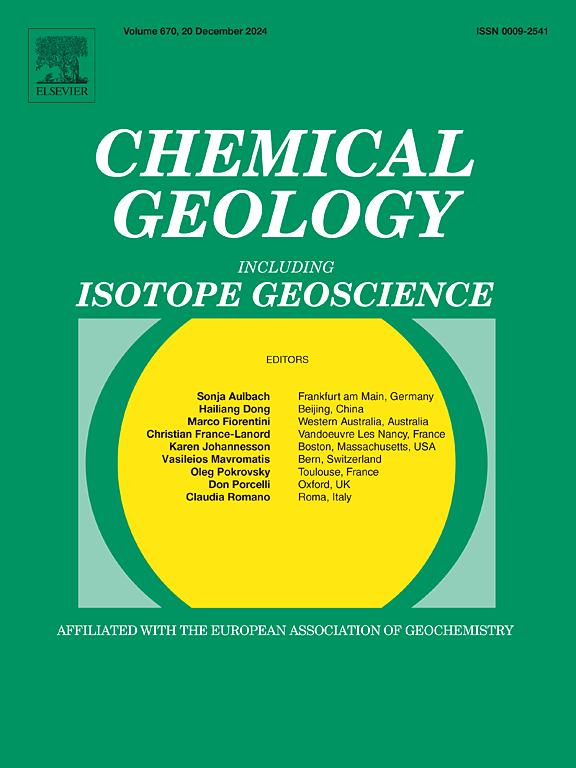Precise discrimination of basalt tectonic settings via dual-stream model with geochemical element matrix and series learning
IF 3.6
2区 地球科学
Q1 GEOCHEMISTRY & GEOPHYSICS
引用次数: 0
Abstract
Precise discrimination of basalt tectonic settings serves as a crucial methodological approach for providing insights into Earth's history. To address the limitations of traditional discrimination methods, which include high subjectivity due to reliance on expert experience and restricted precision resulting from simplistic comparative analysis of geochemical elements, we developed an innovative discrimination model-the Element Matrix and Series Parallel Network (EMSPN). The model enhances the capacity of tectonic setting discrimination by integrating the correlation characteristics between geochemical elements and the sequential features of element reactivity, thereby obtaining more comprehensive lithogenetic information. Based on >39,000 geochemical analyses of basalts from 9 typical tectonic settings after the Archaean period, we conducted application demonstrations through preprocessing operations, including feature engineering, missing value imputation, and category balancing. The proposed model demonstrated superior performance across multiple evaluation methods, achieving an overall discrimination accuracy of 88 %. This study compared the proposed model with four traditional machine learning models as baseline methods, and the results showed that the model outperformed other traditional machine learning models in overall discrimination accuracy across 9 tectonic settings. Additionally, in ablation experiments, by systematically removing key components of the EMSPN, the results validated the model design's rationality and confirmed each module's importance in information extraction and feature learning. Using the SHapley Additive exPlanations (SHAP) method, we analyzed and discussed the importance of different elements in discrimination results and the geochemical characteristics across various tectonic settings. When applied to controversial Archaean basalt samples, the results confirm the conclusions from traditional geochemical analysis methods, demonstrating the model's geological reliability and practical significance. This research provides a reliable technical approach for the field of lithogeochemistry and retrieves geodynamic information through tectonic setting discrimination, contributing to more accurate reconstruction of Earth's tectonic history.
基于地球化学元素矩阵和序列学习的双流模型精确判别玄武岩构造背景
玄武岩构造背景的精确区分是提供对地球历史的见解的关键方法。针对传统的地球化学元素判别方法依赖专家经验而存在主观性强、对比分析过于简单而导致精度受限等局限性,提出了一种新的判别模型——元素矩阵与串并联网络(EMSPN)。该模型综合了地球化学元素的对比特征和元素反应性的序列特征,增强了构造背景判别能力,从而获得更全面的成岩信息。基于对太古宙以后9个典型构造背景下玄武岩的3.9万份地球化学分析,通过特征工程、缺失值估算和类别平衡等预处理操作进行了应用论证。该模型在多种评估方法中表现出优异的性能,总体识别准确率达到88%。将该模型与4种传统机器学习模型作为基准方法进行比较,结果表明,该模型在9个构造背景下的整体识别精度优于其他传统机器学习模型。此外,在烧蚀实验中,通过系统地去除EMSPN的关键组件,验证了模型设计的合理性,并确认了每个模块在信息提取和特征学习中的重要性。利用SHapley加性解释(SHAP)方法,分析和讨论了不同元素在不同构造背景下判别结果中的重要性和地球化学特征。将该模型应用于有争议的太古宙玄武岩样品,验证了传统地球化学分析方法的结论,证明了该模型的地质可靠性和实际意义。该研究为岩石地球化学领域提供了可靠的技术途径,并通过构造背景判别获取地球动力学信息,有助于更准确地重建地球构造历史。
本文章由计算机程序翻译,如有差异,请以英文原文为准。
求助全文
约1分钟内获得全文
求助全文
来源期刊

Chemical Geology
地学-地球化学与地球物理
CiteScore
7.20
自引率
10.30%
发文量
374
审稿时长
3.6 months
期刊介绍:
Chemical Geology is an international journal that publishes original research papers on isotopic and elemental geochemistry, geochronology and cosmochemistry.
The Journal focuses on chemical processes in igneous, metamorphic, and sedimentary petrology, low- and high-temperature aqueous solutions, biogeochemistry, the environment and cosmochemistry.
Papers that are field, experimentally, or computationally based are appropriate if they are of broad international interest. The Journal generally does not publish papers that are primarily of regional or local interest, or which are primarily focused on remediation and applied geochemistry.
The Journal also welcomes innovative papers dealing with significant analytical advances that are of wide interest in the community and extend significantly beyond the scope of what would be included in the methods section of a standard research paper.
 求助内容:
求助内容: 应助结果提醒方式:
应助结果提醒方式:


